
Richmond Hill is a city in Bryan County, Georgia, United States. The population was 16,633 at the 2020 U.S. Census, an increase of almost 80% from the 2010 population of 9,281. Richmond Hill is part of the Savannah Metropolitan Statistical Area.

Brookgreen Gardens is a sculpture garden and wildlife preserve, located just south of Murrells Inlet, in South Carolina. The 9,100-acre (37 km2) property includes several themed gardens featuring American figurative sculptures, the Lowcountry Zoo, and trails through several ecosystems in nature reserves on the property. It was founded by Archer Milton Huntington, stepson of railroad magnate Collis Potter Huntington, and Anna Hyatt Huntington, his wife, to feature sculptures by Anna and her sister Harriet Randolph Hyatt Mayor, along with other American sculptors. Brookgreen Gardens was opened in 1932. It was developed on property of four former rice plantations, taking its name from the former Brookgreen Plantation, which dates to the antebellum period.
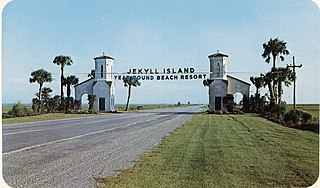
Jekyll Island is located off the coast of the U.S. state of Georgia, in Glynn County. It is one of the Sea Islands and one of the Golden Isles of Georgia barrier islands. The island is owned by the State of Georgia and run by a self-sustaining, self-governing body.
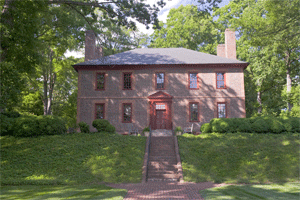
Wilton House Museum is a museum in a historic house located in Richmond, Virginia. Wilton was constructed c. 1753 by William Randolph III, son of William Randolph II, of Turkey Island. Wilton was originally the manor house on a 2,000-acre (8.1 km2) tobacco plantation known as "World's End" located on the north bank of the James River several miles east of the city of Richmond. Between 1747 and 1759, William III acquired more than a dozen contiguous tracts of land. About 1753, Randolph completed building a Georgian manor house, which he named "Wilton," on a site overlooking the river.

Scotchtown is a plantation located in Hanover County, Virginia, that from 1771 to 1778 was owned and used as a residence by U.S. Founding Father Patrick Henry, his wife Sarah and their children. He was a revolutionary and elected in 1778 as the first Governor of Virginia. The house is located in Beaverdam, Virginia, 10 miles (16 km) northwest of Ashland, Virginia on VA 685. The house, at 93 feet (28 m) by 35 feet (11 m), is one of the largest 18th-century homes to survive in the Americas. In its present configuration, it has eight substantial rooms on the first floor surrounding a central passage, with a full attic above and English basement with windows below. It was designated a National Historic Landmark in 1965.

Forest Hill Park, known for its "Stone house" called Boscobel, is a historic 105-acre (0.4 km2) urban park in Richmond, Virginia. Starting as a private property, the park has had several owners and uses before its present one, the City of Richmond.
Ossabaw Island is one of the Sea Islands located on the Atlantic Ocean off the coast of the U.S. state of Georgia approximately twenty miles by water south from the historic downtown of the city of Savannah. One of the largest of Georgia's barrier islands, Ossabaw contains 9,000 acres (3,600 ha) of wooded uplands with freshwater ponds and 16,000 acres (6,500 ha) of marshlands interlaced with tidal creeks. Located between Wassaw Island and the Ogeechee River on the north and St. Catherines Island on the south, the island is not linked to the mainland by bridge or causeway. At 26,000 acres (11,000 ha), it is the third-largest barrier island off the coast of Georgia.
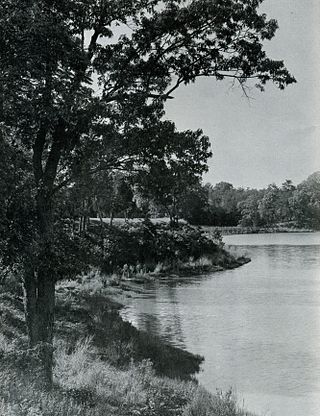
Popes Creek is a small tidal tributary stream of the Potomac River in Westmoreland County, Virginia. The George Washington Birthplace National Monument lies adjacent to Popes Creek estuary.

Hickory Hill is an estate in Hanover County, Virginia. The 3,300 acre former plantation is located approximately 20 miles (32 km) north of the independent city of Richmond and 5 miles (8.0 km) east of the incorporated town of Ashland. The property was listed in the National Register of Historic Places and the Virginia Landmarks Register in 1974.

The Wormsloe Historic Site, informally known as Wormsloe Plantation, is a state historic site near Savannah, Georgia, in the southeastern United States. The site consists of 822 acres (3.33 km2) protecting part of what was once the Wormsloe Plantation, a large estate established by one of Georgia's colonial founders, Noble Jones. The site includes a picturesque 1.5 miles (2.4 km) oak avenue, the ruins of Jones' fortified house built of tabby, a museum, and a demonstration area interpreting colonial daily life.
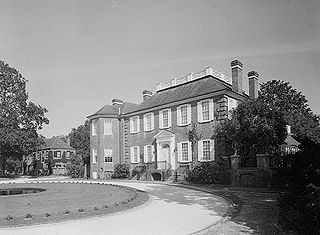
The Fenwick Hall, which is also known as Fenwick Castle, is a plantation house built about 1730 on Johns Island, South Carolina, across the Stono River from James Island and Charleston. It is located between River Road and Penneys Creek. It was named to the National Register of Historic Places on February 23, 1972.

Wild Heron is a historic plantation house approximately fifteen miles south of Savannah, Georgia. It is one of the oldest domestic structures in Georgia and is a relatively intact example of a typical architectural genre which flourished in coastal Georgia and South Carolina in the eighteenth century. Adding to its significance is its association with Francis Henry Harris (1710–1771) and his son, Col. Francis Henry Harris (1740–1782), prominent figures of the Colonial and Revolutionary eras in Georgia, and the operation through two hundred years as a working rice plantation, owned for much of that time by descendants of the same family.
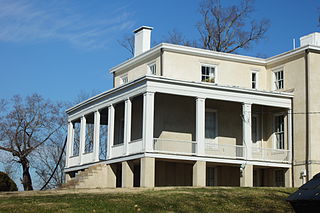
Elk Hill, also known as Harrison's Elk Hill, is a historic plantation home located near Goochland, Goochland County, Virginia. It was built between 1835 and 1839, and is a 2+1⁄2-story, three-bay, stuccoed brick central-hall-plan house in the Greek Revival style. It has a two-story rear ell. The front facade features a one-story Tuscan order portico consisting of paired rectangular wooden pillars supporting a full entablature. Also on the property are the contributing servants' quarters, tack house, and spring house. It was listed on the National Register of Historic Places in 1979.

Strathy Hall is an antebellum plantation house located near Richmond Hill in Bryan County, Georgia. It was constructed circa 1840 by George W. McAllister, the paternal uncle of Archibald McAllister, who owned Strathy Hall Plantation, a large rice plantation on the Ogeechee River.
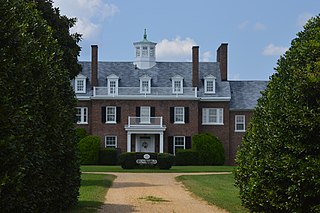
Bushfield, also known as Bushfield Manor, is a historic 2+1⁄2-story Flemish bond, 18th century brick Colonial Revival mansion located in Mount Holly, Westmoreland County, Virginia.
The Civil War Trust's Civil War Discovery Trail is a heritage tourism program that links more than 600 U.S. Civil War sites in more than 30 states. The program is one of the White House Millennium Council's sixteen flagship National Millennium Trails. Sites on the trail include battlefields, museums, historic sites, forts and cemeteries.

Lansdowne is a historic mansion that is listed on the National Register of Historic Places in Natchez, Adams County, Mississippi. It was originally built as the owner's residence on the 727-acre, antebellum, Lansdowne Plantation. The mansion and 120 acres are still owned and occupied by the descendants of the builder, who open it periodically for tours.
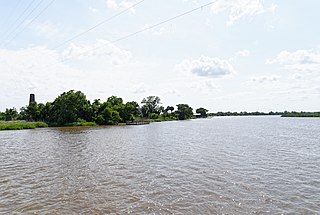
Butler Island is a 1,600-acre (647.5-hectare) island in the Altamaha River in McIntosh County, Georgia, United States. Part of the Altamaha River Delta, the island is located 1 mi (1.6 km) south-southeast of Darien, Georgia.



















